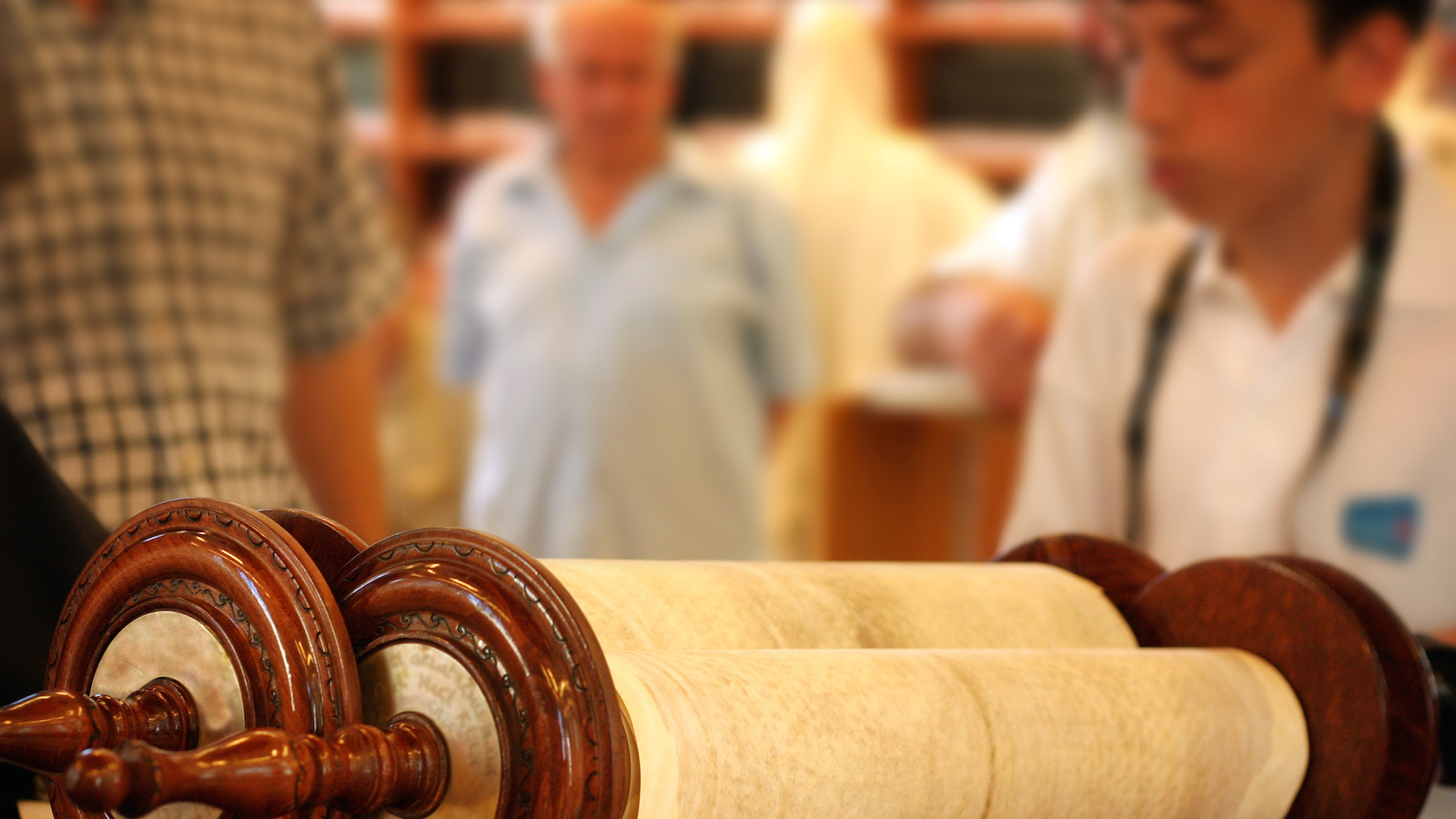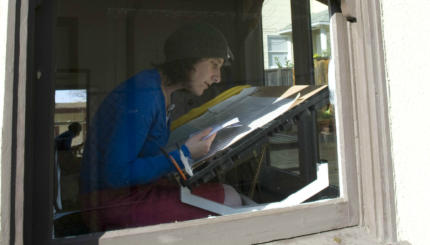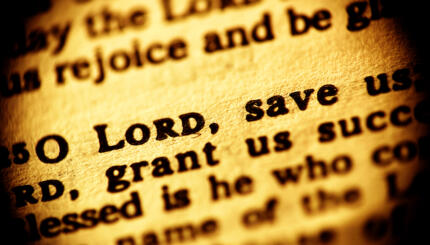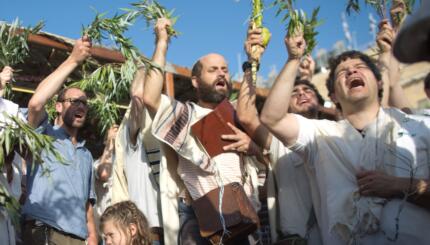Each Shabbat, a portion of the Torah is read, advancing each week until the entire five books of Moses are completed in a single year (three years, in some liberal communities). On festivals, special selections are read outside of this order that either mention the particular holiday or highlight a theme of the festival.
The Torah is also read twice each week, on Mondays and Thursdays, when ancient market days were held in the land of Israel; on Saturday afternoons, the Torah is also read. The service for removing the Torah from the ark, parading it around the congregation, reading it, and then returning it became an opportunity to symbolically reenact the history of Israel, from the giving of the Torah at Sinai to the worship in the Temple in Jerusalem.
Taking Out the Torah
The Torah service begins with the chanting of a series of biblical verses, primarily from the Book of Psalms, describing God’s grandeur and role as king of the universe. In every synagogue, the Torah scrolls are kept in a cabinet called the Aron haKodesh, or holy ark. In Sephardic congregations, the cabinet is called a Ekhal (from the Hebrew word hekhal). Both names, Aron haKodesh and Ekhal, hearken back to the cabinet that housed the tablets of the Ten Commandments in the Holy of Holies in the portable Tabernacle and later in the Temple in Jerusalem. The name confers upon the parchment scrolls a measure of the awe reserved for the stone tablets that, Scripture reports, were written by the finger of God. When the doors or curtains of the ark in a synagogue are opened, revealing the Torahs, it is customary for the congregation to stand just as the Israelites stood at the base on Mount Sinai for the revelation of the Torah.
At this point, the congregation chants the verse from the Torah, “When the ark was carried forward, Moses would say, ‘Arise, Lord! May Your enemies be scattered, may Your foes be put to flight'” (Numbers 10:35). By reciting this verse, the Jews in the synagogue begin the reenactment of the Israelite march through the wilderness with the holy ark in their midst. Collapsing history, the march proceeds metaphorically from Jerusalem, as the next line chanted is, “The Torah shall come from Zion, the word of the Lord from Jerusalem” (Isaiah 2:3).
With your help, My Jewish Learning can provide endless opportunities for learning, connection and discovery.
The Torah is then taken from the ark dressed in an ornamental silver or gold breastplate and crowns over a mantle and belt, evoking the vestments that the biblical priest used to wear, connecting Torah study to Israel’s historic worship with priests and animal sacrifices.
Parading the Torah
Once the Torah is removed, the leader holds the Torah in front of the community and leads the community in chanting the central doxologies of Jewish faith, “Hear O Israel, the Lord is our God, the Lord is one” (Deuteronomy 6:4), “One is our God, great is our Lord, holy is His name,” and “Proclaim the Lord’s greatness with me; let us exalt God together” (Psalms 34:4). As the Torah is then paraded around the sanctuary, the congregation sings a series of verses from I Chronicles 29:11 and Psalm 99:5 and 9, which state, “Yours, O Lord, is the greatness and the power and the splendor. Yours is the triumph and the majesty…Exalt the Lord and worship God, for He is holy…” These verses are intended to accent the presence of God as concretized in the text of the Torah and the drama of marching the Torah.
Aliyah and Chanting the Torah
On Shabbat, the weekly Torah reading is divided into seven sections and the honor of making a special blessing before and after the chanting of each section is distributed to different people in the congregation. Before the Baal Kri’ah, or Torah reader who has prepared to chant one or more of the subdivided portions called an aliyah begins, the congregant honored ascends to the bimah, or stage, to chant the special blessings. This honor is called receiving an aliyah, or literally, “going up,” for it refers not only to physically ascending to the stage where the Torah is read, but also evoking the historic ascent to the Temple in Jerusalem.
Find the Full Text of the Aliyah Blessings Here
The blessing before the Torah begins as an invitation to the congregation, “Praise the Lord, who is blessed.” The congregation then responds, “Praised is God, source of blessing, forever and ever.” The recipient of the aliyah repeats this line and continues, “Praised are You, Lord our God, ruler of the universe who has chosen us from among all peoples by giving us His Torah. Praised are You, Adonai, who gives the Torah.” Upon the conclusion of the Baal Koreh’s chanting, the concluding blessing is recited: “Praised are You, Lord our God, ruler of the universe, who has given us the Torah of truth, planting within us life eternal. Praised are You, Adonai, who gives the Torah.” These blessings are repeated seven times by different people for each of the sections of the Torah chanted. An additional aliyah is given to the person (called the maftir) who will recite a portion from the Prophets called the Haftarah.
Blessings After the Torah Reading
Following the Torah readings, a series of special prayers are chanted on behalf of people who received aliyot to the Torah, those who are ill, those about to be married, those who have just given birth, for young people celebrating their Bar or Bat Mitzvah, and others.
Once the reading of the Torah is concluded, but before the Haftarah is chanted, the Torah is raised and wrapped in preparation to be returned to the ark. As the Torah is raised (called Hagbah), the congregation chants the line, “This is the Torah that Moses set before the people Israel; the Torah, given by God, through Moses.” After the Torah is wrapped but before it is put away, the maftir recites the blessings before (and after) the Haftarah. The opening blessing begins, “Praised are You, Lord our God, ruler of the universe, who has appointed devoted prophets, messengers of truth whose teachings He has upheld. Praised are You, Adonai, who has chosen the Torah, Moses His servant, Israel His people, and prophets of truth and righteousness.”
Following the Haftarah, an extended series of blessings are recited that also speak about God’s promises to His people and speak of the hope that Elijah the prophet will return as a harbinger of the return of a scion of the house of King David. Depending upon whether it is Shabbat or a holiday, these blessings conclude with a mention of the holiness of the day.
At this point, prayers are recited for the health and welfare of the congregation, for the country in which the congregants live, the State of Israel, and world peace. Psalm 145 and its introductory verses, called Ashrei, is recited, and then the Torah is lifted up in preparation for the final parade around the sanctuary. As the Torah is raised, the prayer leader sings, “Let them praise the name of God, for His name alone has been exalted” (Psalm 115:18). The congregation then responds, “His glory is above the earth and heaven. And God will have exalted the pride of His people, causing praise for all of his pious ones, for the people of Israel who are close to Him, Halleluyah!” As the Torah is marched around the sanctuary a final time, the congregation sings Psalm 29 on Shabbat, or Psalm 24 on a festival or weekday. Each of these psalms speak of God’s glory and might in the world.
Returning the Torah to the Ark
As the Torah is returned to the ark, but before the curtains or doors are closed, the verses are chanted, “Whenever the ark was set down, Moses would say: Lord, may you dwell among the myriad families of the people of Israel” (Numbers 10:36). The verses continue, “Return, O Lord, to Your sanctuary, You and Your glorious ark. Let Your priests be clothed in triumph and let Your faithful sing for joy” (Psalm 132:8-10). Once again, the biblical language referring to the ark of the covenant in the Torah and the Temple in Jerusalem is dramatically appropriated by the Rabbis to refer to the ark of the Torah, continually reinforcing the image that the life of Torah and synagogue is a continuous fulfillment of the revelation at Sinai, the march through the wilderness, the conquest of the land, and the worship at the Temple in Jerusalem.
As the ark is closed, the congregation sings, “It is a tree of life to those who hold fast to it, and all of its supporters are happy” (Proverbs 3:18) and “Help us turn to You, and we shall return. Renew our lives as in days of old” (Lamentations 5:21). This conclusion of the service, however, provides a reality check. As much as the life of the synagogue and the Torah service create a sense of Israel’s history existing in the present, the Temple in Jerusalem and the unity of the people that it symbolized is still absent, and Israel awaits its restoration.
aliyah
Pronounced: a-LEE-yuh for synagogue use, ah-lee-YAH for immigration to Israel, Origin: Hebrew, literally, "to go up." This can mean the honor of saying a blessing before and after the Torah reading during a worship service, or immigrating to Israel.
ark
Pronounced: ark, Origin: English, the place in the synagogue where the Torah scrolls are stored, also known as the aron kodesh, or holy cabinet.
Haftarah
Pronounced: hahf-TOErah or hahf-TOE-ruh, Origin: Hebrew, a selection from one of the biblical books of the Prophets that is read in synagogue immediately following the Torah reading.
Shabbat
Pronounced: shuh-BAHT or shah-BAHT, Origin: Hebrew, the Sabbath, from sundown Friday to sundown Saturday.
Torah
Pronunced: TORE-uh, Origin: Hebrew, the Five Books of Moses.



